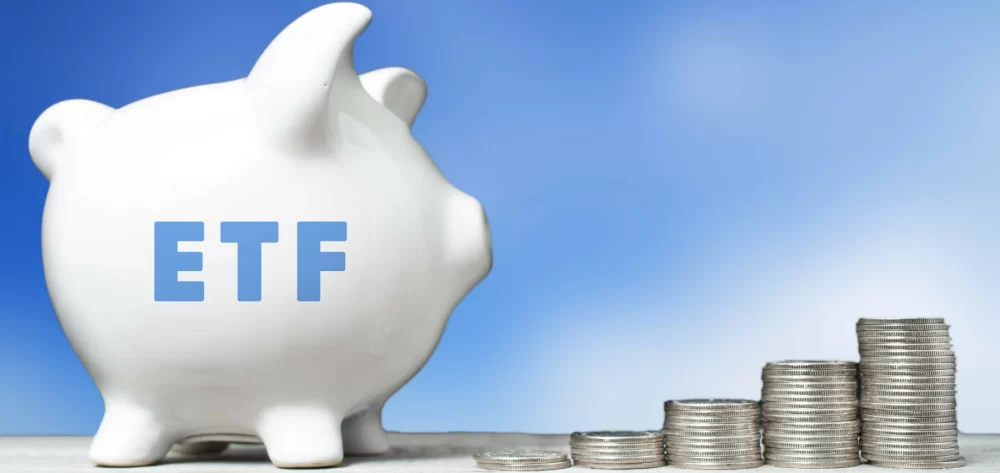Exchange-traded funds (ETFs) are in high demand with private investors. That is not surprising, because passively-managed funds are relatively cheap, and let you access a diversified investment portfolio even with relatively small amounts of capital. ETF shares can be bought and sold easily using a stock brokerage account.
With the huge lineup of different ETFs available, it can be difficult to locate the best match for your investment needs. This guide from moneyland.ch guides you through the process of finding the right ETF.
1. Choose an index or topic
Most ETFs track a stock index or a specific topic. For example, there are ETFs that track the SMI, the SPI, the DAX, or the Nasdaq 100, and there are also ETFs that are focused on specific industry sectors. ETFs can also be used to invest in precious metals like gold and silver, or there are even ETFs for investing in bitcoin.
Before you can choose an ETF, you have to know what you want to invest in. The choice of what to invest in depends on both your personal preferences, and your risk tolerance.
2. Compare TERs
The cost of using an ETF is shown as its total expense ratio (TER). The TER is an ongoing fee that is deducted directly from the fund’s capital. If there are several different ETFs that all invest in the index or theme that you want to invest in, then you have to compare the TERs of these ETFs. While ETFs are generally cheaper than actively managed mutual funds, there are still big differences in the fees charged for different ETFs.
Be aware that in addition to the TER, there are also other costs. These include: brokerage fees and custody fees charged by your bank for buying, holding, and selling ETF shares; currency exchange costs (for ETFs denominated in foreign currencies, for example), and taxes.
3. Check where the fund is domiciled
The ETF’s factsheet normally states which country the fund is domiciled in. The fund’s domicile is the country where the fund is headquartered and legally regulated. Choosing a fund with the right domicile has tax benefits.
The tax benefits primarily affect dividends: Many countries deduct a withholding tax from each dividend payment before it is paid out. Whether or not these withholding taxes can be reclaimed depends on where the ETF is domiciled.
- If you want to use an ETF to invest in Swiss securities, then you should choose an ETF that is domiciled in Switzerland. That way, you can reclaim the 35-percent Swiss withholding tax on dividends in full.
- If you want to use an ETF to invest in securities from countries in the European Union, then choose an ETF that is domiciled in either Ireland or Luxembourg.
- If you want to use an ETF to invest in US securities, then an ETF domiciled in Ireland is optimal because Ireland has double taxation agreements with both the US and Switzerland. ETFs domiciled in Ireland can reclaim half of the 30-percent US withholding tax for dividends from US companies.
4. Stick to ETFs that use physical replication
An ETF’s replication method is the way that it invests in order to copy the performance of a stock index. There are a number of different replication methods:
- Physical replication: The fund managers of a physically replicating ETF actually buy the stocks or other assets that underlie the index in question, and hold them physically.
- Sampling: The ETF’s managers only hold some of the assets that underlie the index they are aiming to replicate. The smaller, less liquid assets that are tracked by the index are excluded from the ETF.
- Synthetic replication: The ETF’s managers replicate the index using swaps. These are contracts with third parties who, for a fee, promise to pay out the difference when the value of the index goes up. The ETF’s managers, for their part, put down a deposit as collateral. This deposit usually consists of liquid stocks or bonds.
Sampling and synthetic replication are primarily used for illiquid assets and for indexes that track a very large number of different assets, such as global stock indexes. These methods generate fewer costs for the ETF’s managers, which typically translates into a lower TER for you as the investor.
But if you have a choice between an ETF that uses physical replication and another that uses synthetic replication, and the costs of both are similar, you should use the physically replicating ETF. That way, your money is actually invested in real assets, and is better protected in the case that the ETF’s fund manager goes bankrupt.
Use the right stock broker
The costs of investing in an ETF do not just depend on which ETF you use, but also on which stock broker you use to buy, hold, and sell your ETF shares. Custody fees and brokerage fees vary broadly between individual banks. The stock brokerage account comparison on moneyland.ch gives you a clear overview of the fees charged by Swiss banks. In addition to differences in fees and charges, banks also vary with regard to the selection of ETFs that they offer. Tip: If you already know which ETF you want to invest in, make sure to use a bank that offers the ETF you want.
5. Currency hedging: Yes, or no?
When you invest money in foreign currencies, there is a risk of losing money if those currencies lose value against the Swiss franc. This risk applies if the assets you are investing in – the stocks held by an ETF, for example – are denominated in a foreign currency.
To minimize the currency exchange risk, many ETFs are offered in a version that has currency hedging. You can recognize these because the word hedged appears in the ETF’s title. However, an ETF with currency hedging is normally much more expensive than the same ETF without currency hedging. For that reason, using hedged ETFs often does not make financial sense. ETFs with currency hedging are only worth considering if you are concerned about the currency exchange risk and are willing to pay to avoid this risk.
6. Choose the right stock exchange
Many banks and other stock brokers let you choose between more than one stock exchange on which to buy the same ETF. The brokerage fees charged by Swiss banks can be higher or lower depending on which stock exchange you use. Note that the location of the stock exchange is not the same thing as the ETF’s domicile (see point 3).
You should choose the stock exchange that your bank charges the lowest brokerage fees for. Some Swiss banks pass on the stock exchange fees charged by the exchanges themselves, but these fees are generally negligibly low.
You can find more information about the taxes, fees, and duties that apply when you buy shares in ETFs or stocks in the guide to stock exchange fees and government duties.
7. Distributing or accreting?
Many ETFs are offered in both distributing and accreting versions. Which of the two versions you should use depends on your investment goals. Accreting ETFs reinvest dividends back into the fund directly. If you are looking to grow your wealth over the long term and do not need dividend income, then an accreting ETF is a good fit for you.
But if, on the other hand, you are looking to earn a regular income from the dividends paid out by the ETF in order to cover your living expenses, then you should use a distributing ETF. In this case, the dividends are paid out to your account with each distribution.
More on this topic:
Compare Swiss stock brokerage accounts now
How to invest money in Switzerland




